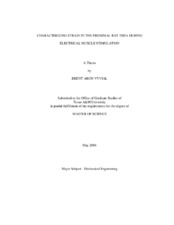| dc.description.abstract | Hindlimb unloading is a widely used model for studying the effects of
microgravity on a skeleton. Hindlimb unloading produces a marked loss in bone due to
increased osteoclast activity. Electrical muscle stimulation is being investigated as a
simulated resistive exercise countermeasure to attenuate this bone loss. I sought to
determine the relationship between strain measured at the antero-medial aspect of the
proximal diaphysis of tibia and plantar-flexor torque measured at the ankle during
electrical muscle stimulation as an exercise countermeasure for hindlimb unloading in
rats. A mathematical relationship between strain and torque was established for the
exercise during a 28 day period of hindlimb unloading. The strain generated during the
exercise protocol is sufficient to attenuate bone loss caused by hindlimb unloading.
Twelve six-month old Sprague-Dawley rats were implanted with uni-axial strain gages
in vivo on the antero-medial aspect of the proximal diaphysis of the left tibia. Strain and
torque were measured during electrical muscle stimulation for three time points during
hindlimb unloading (Day 0 (n=3), Day 7 (n=3), Day 21 (n=3)). Peak strain decreased
from 1,100 strain at the beginning of the study to 660 strain after 21 days of hindlimb
unloading and muscle stimulation. The peak strain rate measured during muscle
stimulation was 10,350 strain/second at the beginning and decreased to 6,670 strain/second after 21 days. The changes in strain are not significant, but the
underlying trend in strain values may indicate an increase in bone formation due to the
electrical muscle stimulation countermeasure. A mathematical model that relates
measured strain to peak eccentric torque during muscle stimulation was created to facilitate estimation of strain for future studies of electrical muscle stimulation during
hindlimb unloading. | en |


